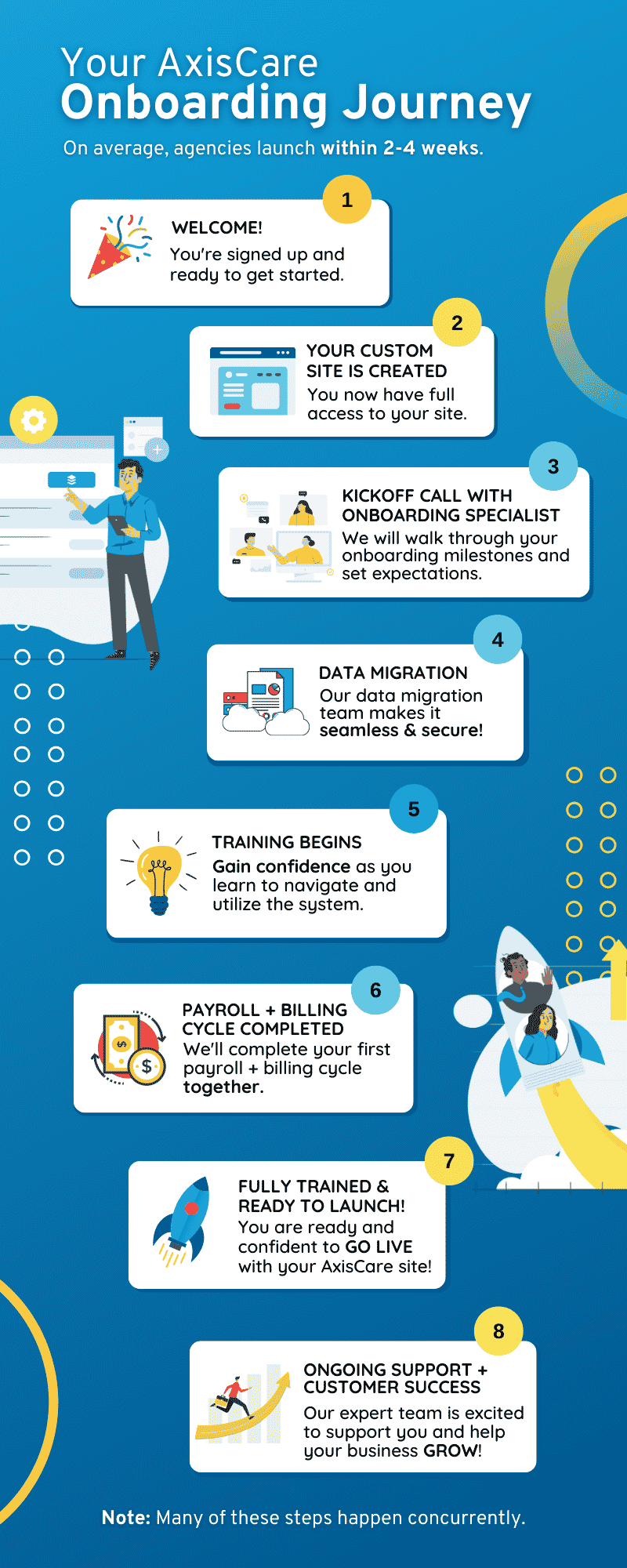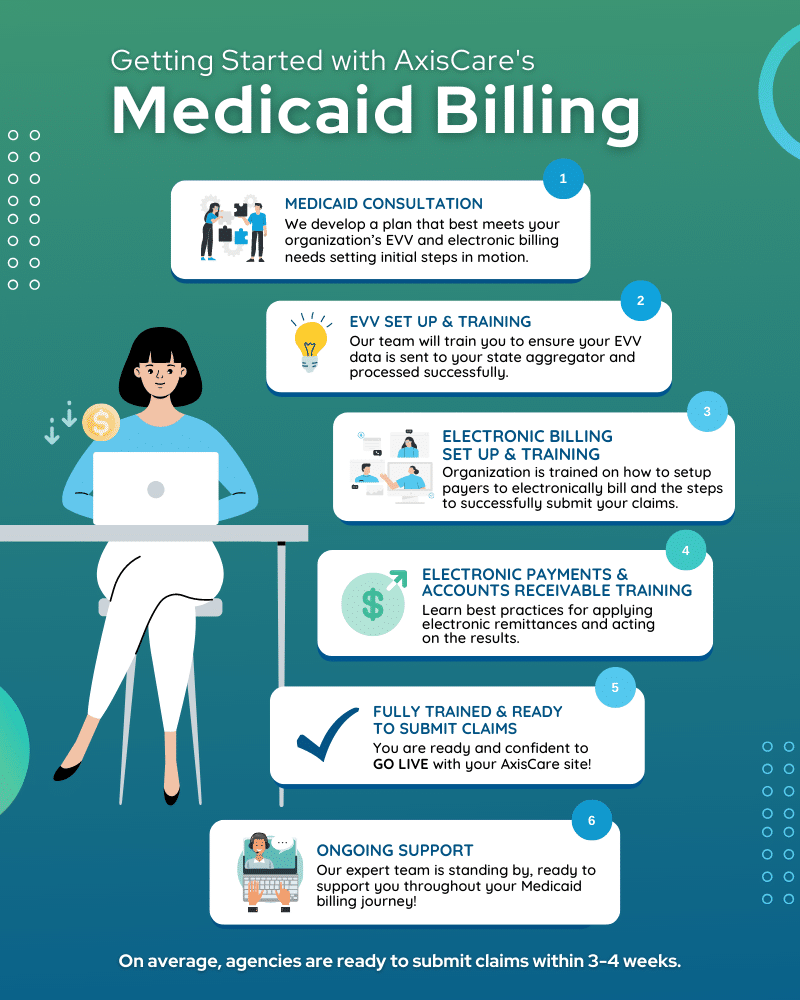Setting Key Performance Indicators for Home Health Care
Introduction
Key Performance Indicators (KPIs) measure success and progress across a variety of business metrics, reflecting an organization’s core goals. Teams track many KPIs simultaneously to monitor every corner of their operations. Without this constant monitoring, organizations wouldn’t know whether they’re on track to meet objectives or whether adjustments must be made to better align their efforts with their desired outcomes.
In a field as personal as home care, KPIs aren’t just about hard data or the bottom line. They provide clear insights into the quality of care being delivered, from client recovery times and hospitalization rates to caregiver retention and client satisfaction.
Home care KPIs should, therefore, exist at the crossroads of client-centered outcomes and business success: when indicators that reflect compassionate, effective, and reliable care are prioritized, performance improvements will naturally follow.
Why KPIs Matter in Home Health Care
The home care industry is subject to a uniquely rigorous blend of clinical, legal, and operational demands. Quality of care and regulatory compliance require equal attention, alongside staffing challenges and financial sustainability. KPIs are the glue that connects these disparate goals, creating a unified tracking framework that allows agencies to monitor all of their objectives in parallel.
Regulatory bodies and payers are increasingly tying reimbursements to care quality metrics like readmission rates and timely documentation; without a system in place for agencies to prove they’re up to scratch, they’re putting themselves at risk of penalties and lost revenue.
Meanwhile, ensuring clients are satisfied with their service and caregivers feel well taken care of is critical for retention and referrals. Measurable benchmarks hold agencies accountable to all these goals, pinpointing exactly where they excel and where there’s room for improvement.
Key Areas of Performance Measurement
KPIs serve as both clinical and operational tools by keeping a finger on the pulse of business success and people-centric satisfaction. Clinically, they ensure that clients are receiving safe, effective care and that caregivers aren’t churning at an alarming rate. Operationally, they drive efficiency and support workforce management, all of which pave the way for profitability.
Client Care & Clinical Outcomes
Home care KPIs are somewhat of a feedback loop: it all starts with care plan adherence, which measures how closely clients follow the health recommendations set out by their care team. This can include taking their medication on time, following physical therapy routines, and promptly reporting symptoms of illness.
The closer clients stick to their care plans, the less likely they are to end up back in the hospital after their most recent discharge. In practice, an agency might aim to reduce 30-day readmissions for heart failure clients by 10% through improved medication tracking and early interventions. Weaving digital client engagement touchpoints like online portals and mobile apps into this framework is a great way to encourage active participation among clients and their families
Client recovery progress measures clinical improvements over time, often through standardized assessments or scoring tools – for example, improved mobility scores among clients recently undergoing surgery or decreased pain levels among clients living with chronic conditions.
Client Satisfaction & Engagement
Satisfaction and engagement KPIs encapsulate how clients and families experience care. One such KPI is service accessibility: how easy is it for clients to receive the services they need? Are appointments readily available? Are there enough specialists to go around?
Agencies may choose to collect feedback via satisfaction surveys, which can include questions about caregiver communication, punctuality, and overall trust in the care team. Tracking satisfaction scores over time allows agencies to monitor the consistency of their service and correct shortcomings to prevent churn.
Any “hard data” collected through a survey will ideally be backed up by supporting commentary – for example, phone check-ins or post-visit reviews. These richer insights offer important context behind the numbers, highlighting subtle factors influencing the overall experience.
Operational & Staffing Efficiency
Keeping your staff happy and engaged is just as important as client satisfaction: your team is the bedrock of your entire operation, and without them, your doors would shut overnight.
One key KPI in this arena is caregiver scheduling efficiency, which tracks how well shift assignments are aligned with client needs and caregiver availability. Poor scheduling can lead to gaps in care, overtime costs, and burnout, while efficient scheduling reduces travel distance and last-minute cancellations.
Caregiver retention is another vital metric, which is usually measured based on annual turnover rate or average tenure. High caregiver turnover sends recruitment and training costs sky high, disrupts the continuity of care, and impacts client satisfaction as shortages snowball into service gaps. By tracking retention trends, agencies can identify issues such as imbalanced workloads and high churn to stop issues from escalating.
On a day-to-day scale, it’s common for agencies to track visit completion rates: the percentage of scheduled visits that occur as planned. High completion means your operations are running smoothly, while missed visits can signal staffing issues or scheduling inefficiencies. Finally, time efficiency metrics—like the average time spent on documentation or traveling between clients—help agencies identify bottlenecks and streamline their workflows accordingly.
Best Practices for Selecting KPIs
Every tracked metric should reflect the agency’s overarching mission, whether that’s improving client outcomes or boosting caregiver satisfaction. These specific goals will be finely tuned to each agency’s situation. For example, one agency may be having a tough time with hospital readmissions, meaning they’ll need to set a very ambitious goal for readmission reduction. The agency down the road may also monitor this KPI, but with an eye towards maintenance instead of reduction.
KPIs should be specific, measurable, and actionable – if they’re not, you’ll never know if you’re on track. Vague metrics like “better care quality” don’t offer clarity. Instead, use quantifiable benchmarks like:
- Reduce hospital readmissions by 10%
- Achieve a 95% visit completion rate
- Increase caregiver retention by 5% by EOY
- Reduce caregiver overtime by 20% through optimized route planning
- Resolve all client complaints within three business days
Tools & Technology for Tracking KPIs
Agencies that use home care software to manage their operations can collect data at all hours of the day—no human intervention is required. A suite of complementary tools can transform raw data into actionable insights, making it easier to measure and improve care delivery without additional administrative burden.
Electronic Medical Records (EMRs) are the entry point for most KPI data. These logs automatically capture clinical and operational information during appointments, including visit completion, documentation timeliness, and client progress. Instead of relying on manual spreadsheets or non-standardized reports, agencies can pull accurate data directly from clients’ care records in real time.
Dashboards and KPI scorecards organize that data into visual arrangements that are simple, intuitive, and easy to read at a glance, so care team members can quickly understand how the agency is performing. Analytics platforms squeeze even more value out of this data: They allow agencies to compare performance across teams or time periods, uncover patterns, and even predict risks based on empirical trends.
Business intelligence (BI) goes hand in hand with analytics. While analytics is more heavily associated with using current data to forecast trends, BI organizes and visualizes data in a way that’s easy for users to understand. AxisCare’s BI features unite all essential metrics and KPIs under a single digital roof, displaying operational and employee data through intuitive charts and dashboards. These clear and intuitive displays make it easier than ever for agencies to make data-driven business decisions.
Monitor & Achieve KPIs Effectively With AxisCare
Hit your KPIs every time with a home care platform designed for agency success. AxisCare gives organizations the tools to streamline every level of their operations and track progress as they evolve, keeping clients and caregivers happy for a healthy and thriving business. Request a free demo to learn about what we can do for you.





